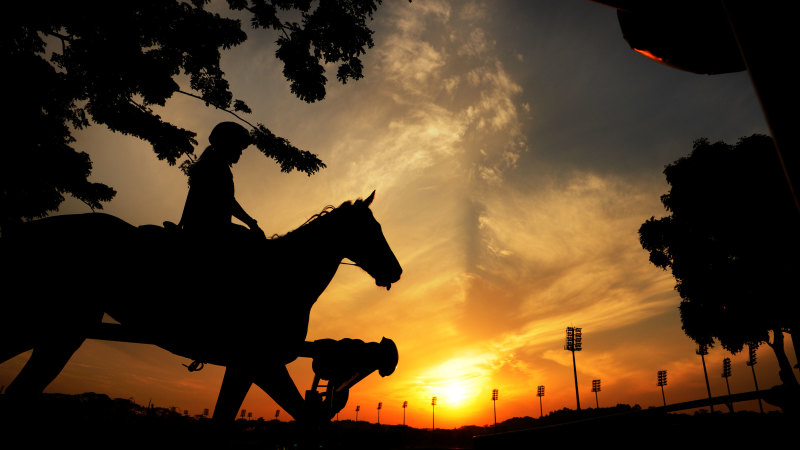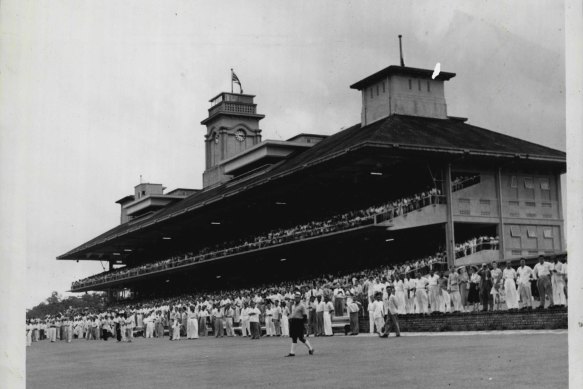
Why Singapore is turfing its turf club
September 22, 2023Save articles for later
Add articles to your saved list and come back to them any time.
What in the World, a free weekly newsletter from our foreign correspondents, is sent every Thursday. Below is an excerpt. Sign up to get the whole newsletter delivered to your inbox.
On the pavement beside the finishing straight at Singapore’s Kranji racecourse, older men, affectionately known as uncles, lean against the railing, race books and betting slips in hand, as horses charge towards the line.
Pre-race trackwork at Kranji racecourse, Singapore.Credit: Vince Caligiuri
Upstairs, in the five-storey grandstand, racegoers take in the action in more comfortable surrounds. It’s a typical day at the Singapore Turf Club, but days like these will soon be over.
In June, a sudden announcement was made: the club would hold its last race meet in October 2024 before being closed down, drawing the curtain on the sport of kings after 180 years. The reason? The club’s 120-hectare facility on the island’s urban fringe is to be returned to the government for redevelopment.
Singapore is densely populated − 6 million people live in an area smaller than Canberra − and more room is needed for housing and recreational use, Indranee Rajah, the second minister for finance and for national development, told parliament.
In 1950, the Singapore Turf Club’s course was in Bukit Timah.Credit: Nine
It is a turn of events that has parallels in Australia’s major cities. In Sydney, the Harold Park Paceway in the inner-west suburb of Glebe became a residential precinct and the Tramsheds food hub after the NSW Harness Racing Club sold to developer Mirvac in 2010. A little further out, Canterbury Park Racecourse has been the subject of sell-off talk which has so far been met by fierce resistance from the local community.
In Melbourne, meanwhile, there is renewed discussion about Sandown Racecourse − run by the Melbourne Racing Club in the city’s south-east − making way for 7500 new homes.
Unlike the Australian examples, however, the decision here was made by the government, which has indirect but ultimate control of the turf club.
The real estate landscape here is also distinctive. While condominiums and bungalows go for eye-watering sums on the open market as cash pours in from overseas, the majority of Singaporeans live in flats built and subsidised by the government.
Even so, rising prices across the board have made housing affordability and access a hot topic. It has been high on the agenda for the long-ruling People’s Action Party as Prime Minister Lee Hsien Loong navigates a succession plan after two decades in charge and as his government looks to shake off a series of recent scandals.
Singapore’s gaping wealth divide has also been emphasised by the seizing of $1 billion in properties, cars and gold bars in a money-laundering probe that has made headlines in the past month.
As the death knell was sounded for horse racing in favour of satisfying housing needs, fading interest in the sport here has also been cited as a factor. It wasn’t always the case. Racing was introduced to Singapore in 1842, and it was once thought that it could ascend to be an equal of Asian racing heavyweights Hong Kong and Japan. The turf club drew average crowds of 11,000 as recently as 2010 and hosted top international trainers and jockeys. Queen Elizabeth II was trackside at Kranji in 2006 to present the winner’s cup for a race named in her honour.
In the past decade, however, attendances have declined, dropping to an average of 2600 in 2022, as has wagering revenue, from $1.8 billion to $1.1 billion since 2010, according to turf club chairman Niam Chiam Meng.
The opening of sparkling casinos at Marina Bay and Sentosa island has cut into race betting’s turnover and general appeal, and it was positioned as an “old man’s game” by young people in one Singaporean media report after the announcement about the turf club’s demise.
As you might expect, racing’s forced ending hasn’t gone down well in the industry. The livelihoods of hundreds of trainers, riders and other staff have been upended and the more than 700 local racehorses will have to be sent abroad.
Michael Clements, a Zimbabwean who has trained in Singapore for a quarter of a century and is president of the trainers’ association, believes racing’s slide might have been averted with better promotion and the guiding hand of leaders with greater experience in the field.
Taken aback by the shutdown news, he said this week he would be closing his stable at the end of the month.
Michael Cox, the editor of news site Asian Racing Report and a former reporter with The Age, also finds it hard to fathom that Singapore is dispensing with racing just 24 years after the opening of its $500 million headquarters. The turf club site had previously been in more central, trendy Bukit Timah before that location was slated for residential development, which hasn’t yet materialised.
“If you go to the housing estates when the races are on, people will be betting on racing and there’s a culture with uncles going to the betting shops,” Cox said.
“Singapore has all the elements that successful racing jurisdictions have. But racing didn’t have political advocacy … it didn’t have a [Racing NSW chief executive] Peter V’landys or a Hong Kong Jockey Club.”
Rajah, the second minister, told parliament it “was not an easy decision, nor was it made lightly” but she said the government had sought feedback from the public and the prevailing view was that more land was required for housing.
“Singapore is a city-state with limited land. The government continually reviews its land use plans to meet today’s needs while ensuring there is sufficient land for future generations,” a spokesperson for the Ministry of Finance told me.
“The Singapore racecourse site will be used for housing, including public housing. The Ministry of National Development is also studying other potential uses, including leisure and recreation.”
On Saturday, the uncles will be back at the track for one of the feature events on the calendar, the Raffles Cup. The end of a long era is approaching.
Get a note directly from our foreign correspondents on what’s making headlines around the world. Sign up for the weekly What in the World newsletter here.
Most Viewed in World
From our partners
Source: Read Full Article




